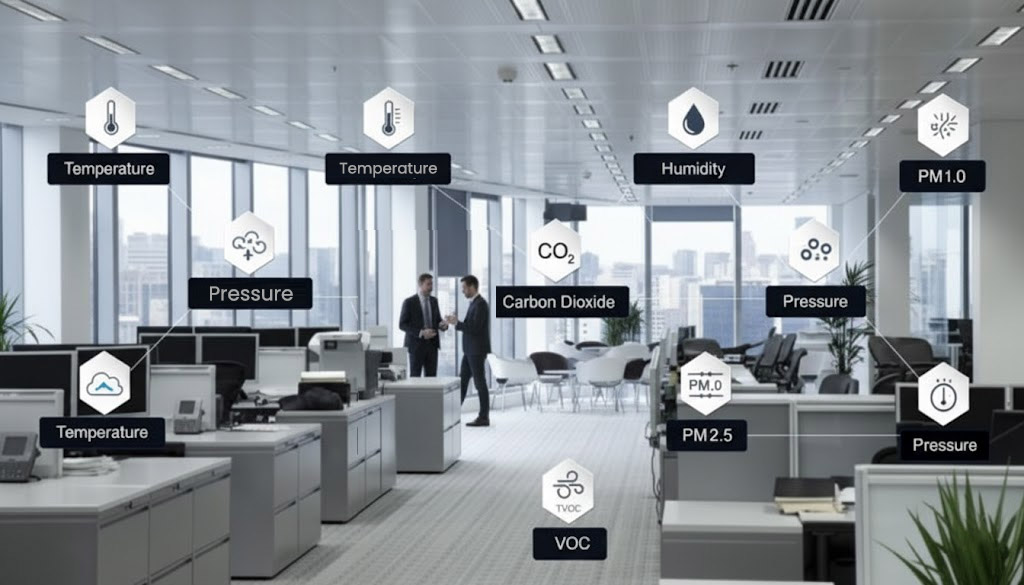The Long-Term Benefits of Monitoring Air Quality: Insights for a Healthier, Smarter Environment
In today’s world, where we spend nearly 90% of our time indoors, understanding and improving air quality is no longer a luxury—it’s a necessity. While short-term air quality readings can help identify immediate issues, long-term air quality monitoring provides the data depth needed to uncover hidden trends, optimize building performance, and safeguard occupant health over time.
Why Long-Term Air Quality Monitoring Matters
Air quality can fluctuate daily due to factors such as outdoor pollution, ventilation cycles, building occupancy, cleaning products, and seasonal changes. A one-time measurement often paints an incomplete picture. Continuous or long-term monitoring allows organizations, facility managers, and homeowners to identify recurring issues and act before they escalate.
For instance, an office may notice that CO2 levels spike every afternoon—a sign of inadequate ventilation during peak occupancy. Without consistent data, such patterns remain invisible, leading to productivity loss and fatigue. Similarly, schools that track particulate matter (PM2.5 and PM10) throughout the year can detect how pollution from nearby traffic or construction impacts indoor learning environments.
Key Benefits of Long-Term Monitoring
Trend Analysis and Predictive Insights

Continuous data reveals long-term exposure patterns. By analyzing weeks or months of CO2, particulate matter, humidity, and temperature data, you can identify what times or conditions cause deterioration in air quality. Predictive analysis powered by historical data helps you anticipate and prevent issues—rather than simply react to them. Explore how historical insights enhance decision-making in this article.
Data-Driven Building Management

Facilities that monitor air quality over time can fine-tune their HVAC systems for efficiency. Real-time and historical CO2 data, for example, can be used to adjust ventilation rates dynamically, balancing comfort, energy use, and compliance. This continuous feedback loop supports smart-building strategies and ESG-driven sustainability goals.
Health and Productivity Improvements
Prolonged exposure to elevated CO2 or particulate matter impacts cognitive performance, focus, and general well-being. Long-term monitoring enables early detection of subtle yet harmful conditions, such as increased VOC levels from new furnishings or high humidity leading to mold formation. Addressing these issues improves comfort, reduces absenteeism, and supports a healthier workforce.
Compliance and Environmental Reporting
Long-term data records are essential for demonstrating compliance with air-quality standards (such as ASHRAE 62.1 or WHO guidelines) and for inclusion in sustainability or ESG reports. Reliable monitoring tools help businesses show their commitment to indoor environmental quality (IEQ) and occupant well-being. You can learn more about compliance strategies in this detailed post
Comparing Indoor and Outdoor Conditions
Seasonal outdoor pollution, wildfires, or nearby industrial activity can significantly influence indoor environments. By monitoring long-term indoor data alongside local outdoor readings, facility managers can make informed ventilation and filtration decisions. See also How Outdoor Air Quality Impacts Indoor Environments.
How Smart Monitoring Makes the Difference
Modern systems like HibouAir make long-term air quality tracking simple and scalable. Each HibouAir device measures critical environmental parameters—CO2, particulate matter (PM1.0, PM2.5, PM10), temperature, humidity, VOCs, and noise—and delivers data in real time through intuitive platforms.

Using the HibouAir Cloud Dashboard, users can visualize trends, compare historical data, and set up alerts. For standalone users, the Desktop Solution offers local storage and analytics without requiring constant internet connectivity. Whether in offices, schools, museums, or industrial facilities, these insights empower decision-makers to maintain optimal air quality 24/7.
Real-World Example: A Year-Long Office Study
A medium-sized business installed continuous CO2 and particulate sensors throughout its office spaces. Over twelve months, data revealed consistent afternoon CO2 peaks exceeding 1,200 ppm, correlating with employee fatigue and complaints of “stuffy” air. By integrating the data into their HVAC control system, ventilation was increased automatically when thresholds were reached. The result? A 25% reduction in reported headaches and a measurable improvement in focus and energy levels.
Building a Healthier Future Through Data
Air quality is dynamic—it changes with time, usage, and behavior. Short snapshots can miss the story; long-term monitoring tells the full narrative. With reliable data, organizations can move from reacting to preventing, from assumptions to insights, and from discomfort to well-being.
If you want to explore modern solutions for real-time and long-term air quality management, visit HibouAir.com to learn more about available monitoring options.

